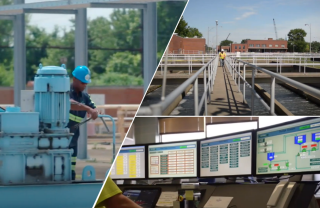Tools, Training, and Technical Assistance to Increase Water System Resilience Webinar
- Watch the webinar recording (January 30, 2024)
- Small Drinking Water Systems Webinar Series
About the Webinar

1. Creating Resilient Water Utilities
Climate change impacts pose an immediate and long-term threat to the continuity of wastewater, stormwater, and drinking water utility operations and water supplies. To reduce the risks associated with climate-related hazards, EPA's Creating Resilient Water Utilities (CRWU) initiative provides training, tools, and technical assistance designed to educate the water sector on climate science and adaptation options. This presentation will highlight the Resilient Strategies Guide, an application that guides water utility owners and operators through identifying adaptation strategies to address their climate resilience priorities. This tool is useful for utilities of any size and at any stage of their climate adaptation planning process. This session will also preview other CRWU resources, including the Climate Resilience Evaluation and Awareness Tool, Climate and Weather Data Maps, and Environmental Justice StoryMap. This presentation will communicate the real-world challenges and successes of utilities in adapting to the impacts of climate change and focus on CRWU’s efforts to provide technical assistance to small water systems through a utility case study.
Presenters:
Nash Keyes, EPA Office of Water. Nash (they/them) is an ORISE Fellow with EPA’s Creating Resilient Water Utilities (CRWU) team. They received their bachelor’s degree in applied mathematics from Yale University, and they have research experience in climate modeling and GIS. Nash is passionate about applying their technical skills to building climate resilience and environmental justice in the water sector.
Aliza Furneaux, EPA Office of Water. Aliza (she/her) supports the EPA’s Creating Resilient Water Utilities Initiative as an Environmental Protection Specialist. Before joining the EPA, she worked in the water reuse sector as a Technical and Regulatory Program Director at the WateReuse Association.
2. EPA's Water Network Tool for Resilience (WNTR)
Drinking water utilities face multiple challenges, including aging infrastructure, water quality concerns, pipe breaks, uncertainty in supply and demand, natural disasters, environmental emergencies, and terrorist attacks. All of these have the potential to disrupt service to customers and damage critical infrastructure. Increasing resilience to these types of hazards is essential to improving water security. Simulation and analysis tools can help water utilities predict how their system will respond to expected, and unexpected, incidents and help inform decisions to make water distribution systems more resilient over time. EPA, in partnership with Sandia National Laboratories, developed the Water Network Tool for Resilience (WNTR), an open source Python package, to integrate critical aspects of resilience modeling for water distribution networks into a single software framework. WNTR can help water utilities investigate the resilience of their water systems to a wide range of hazardous scenarios and evaluate emergency response actions and long-term resilience‐enhancing strategies. The software estimates potential damages from disaster scenarios; predicts how damage to infrastructure would occur over time; evaluates preparedness strategies; prioritizes response actions; and identifies worse case scenarios, efficient repair strategies, and best practices for maintenance and operations. This presentation will provide an overview of WNTR along with a few case study applications.
Presenter: Terra Haxton, Ph.D., EPA Office of Research and Development. Terra (she/her) is an engineer in the Center for Environmental Solutions and Emergency Response within EPA’s Office of Research and Development. Since joining EPA in 2007, she has helped develop water system modeling approaches to assist drinking water utilities in improving security and resilience to natural disasters.
